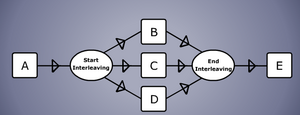XO Korea/yawl: Difference between revisions
< XO Korea
Jump to navigation
Jump to search
No edit summary |
No edit summary |
||
| Line 9: | Line 9: | ||
** [http://is.tm.tue.nl/research/patterns/ workflow patterns] |
** [http://is.tm.tue.nl/research/patterns/ workflow patterns] |
||
** [http://is.tm.tue.nl/research/patterns/flash_animations.htm flash animation] |
** [http://is.tm.tue.nl/research/patterns/flash_animations.htm flash animation] |
||
Before you participate in writing codes for e-Governments or e-Business modules, it is strongly recommended to read three kinds of documents below. |
|||
* YAWL: what is YAWL and how to use it. |
|||
* [[XO Korea/oea]]: what is ''Open Enterprise Architecture'' and how to use it. |
|||
* [[XO Korea/workflow description]] of each target service or function: in-depth description of the module desired to be written. |
|||
Revision as of 16:36, 19 May 2007
YAWL is a Workflow/BPM system. Based on a concise and powerful modelling language; YAWL handles complex data, transformations & Web Service integration. Built in Java, it uses XML Schema, XPath/Query, & XForms natively. It is compatible with SOAP & WSDL.
XO Korea uses YAWL to visually diagram workflow of any function or service, including those of governmental business sections.
Before you participate in writing codes for e-Governments or e-Business modules, it is strongly recommended to read three kinds of documents below.
- YAWL: what is YAWL and how to use it.
- XO Korea/oea: what is Open Enterprise Architecture and how to use it.
- XO Korea/workflow description of each target service or function: in-depth description of the module desired to be written.
